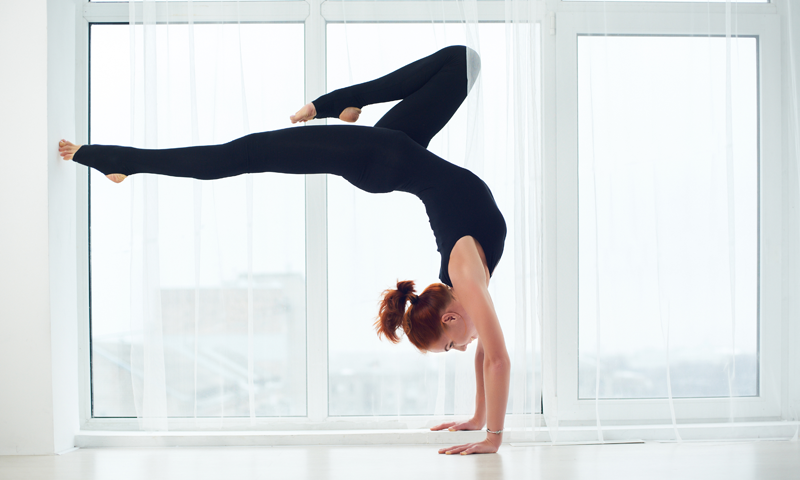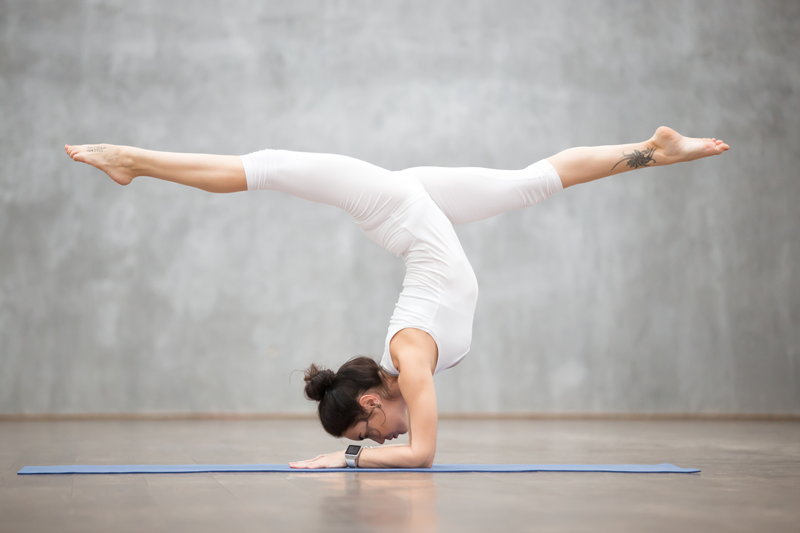
Mysore: The Answer to the Universe
31st January 2020
7 Things Yoga Taught Me About Women
7th February 2020This Sequence Will Help You Safely Perform Inversions

When practising yoga, certain parts of the body are more delicate than others. For instance, most practitioners need to pay close attention to the spine, knee and hip joints because they are most prone to injury. However, when it comes to inversions, it’s the shoulders you need to watch out for.
The shoulder is a ball and socket joint where the shoulder blade and upper arm intersect. The socket is a small, bowl-shaped area on the outside of the shoulder blade. The socket is more shallow than other joints in the body, giving the shoulder unbeatable mobility. During inversions, it’s important to externally rotate the upper arms to avoid injury.
Unfortunately, the bone can pop out of the socket fairly easily, particularly during advanced inversions. To avoid this, you need to build strength in the surrounding muscles to keep it stable. Thankfully, this sequence will help you safely perform inversions. Pop on your favourite yoga pants and work through the postures below.
Chair Pose
Chair Pose raises the arms above the head to improve flexibility. To practice the asana, stand tall with your big toes touching. Taking a deep breath in, raise your arms above your head and point your fingertips toward the sky. Draw your shoulders back and lengthen your neck. As you exhale, bend your knees and begin to lower your bottom down and back, much like you would when sitting on a chair. At this stage, it’s important to not let your knees extend past your toes. Each time you inhale, lengthen your spine a little more. With each exhale, deepen the stretch by lowering your bottom further toward the floor. You are in Chair Pose. For best results, remember to keep your abdominal muscles engaged and ensure that your thighs are touching throughout. Hold the posture for 30 seconds whilst breathing deeply.
Side Plank
Side Plank is perfect for building strength in the shoulders and upper body. Additionally, it helps to improve balance and stability. To practice Side Plank, begin in Plank Pose. From here, slowly move your body over to your right foot and stack your left foot over your right. Lift your left arm towards the ceiling as you stack your left shoulder and hips over the right side. To hold the posture, maintain strength in your arms and draw your belly button towards your spine. You are in Side Plank. Hold the posture for as long as possible before repeating on the other side.
Supine Twist
To practice Supine Twist, begin by lying on your back. Bring your arms out into a T position with your palms facing down. Next, bend your right knee and place your right foot on the left knee. As you exhale, move your right knee over to the left side of your body by twisting the spine and lower back. Move your head to look at your right fingertips and keep your shoulders flat on the floor. You are in Supine Twist. Hold the asana for around 10 breaths before repeating on the other side.

Bow Pose
To practice Bow Pose, lie flat on your stomach. Next, bend both your knees and bring your legs up behind you. Slowly lift your chest off the ground and reach your arms back to grab your feet. You are in Bow Pose. Hold the posture for around 30 seconds before releasing your feet and lowering your legs back to the mat.
Camel Pose
To practice Camel Pose, kneel on your mat with your knees below your hips. Place your hands on your bottom, keeping your fingers pointing down. Take a deep breath in and move your pelvis forward; as you do so, lean your head and torso back. At this point, you should feel a deep stretch in your upper thighs. Next, reach your left hand back and touch the heel of your left foot. If you’re flexible enough, do the same on the right side. Finally, move your pelvis forward and round your spine. You are in Camel Pose. Hold the asana for 30 seconds whilst breathing deeply.
Downward Dog
To practice Downward Dog, stand tall with your feet shoulder-width apart. Bending at the waist, slowly lower your torso forward until your body forms a triangle. Your hands and feet should now be securely on the ground. If your shoulders or hamstrings feel too tight for the pose, try bending your knees slightly to make the posture easier. Spreading your fingers for additional balance, move your head forward until it is in-between your upper arms. You are in Downward Dog. For best results, hang your head gently between your shoulders and breathe deeply throughout.
Warrior One
Let’s finish the sequence with Warrior One. To practice the asana, begin standing tall on your mat. Keeping your left leg in place, take a big step forward with your right leg. Next, bend your right leg and stretch your left leg out behind you. Finally, roll your shoulders back and lift your arms above your head. You are in Warrior One. Hold the asana for around 30 seconds before switching sides.
In Summary
Suffering from weakness or instability in the shoulders? Don’t panic. This sequence will help you safely perform inversions. When practised regularly, the asanas will help build strength and improve flexibility in the shoulders, allowing you to practice inversions safely and without injury. Better still, all you need to practice is a comfortable yoga top and a good quality mat. As soon as you’ve got those things, you’ll be good to go.

